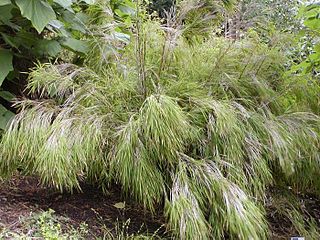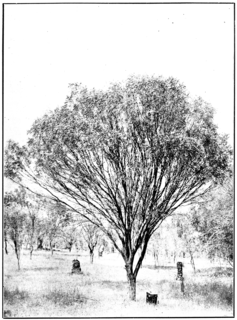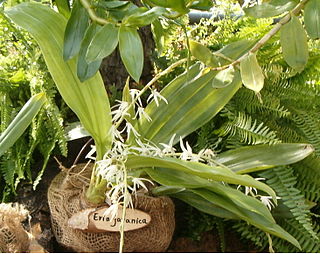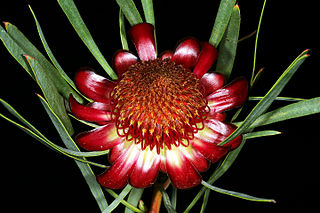
The term kola nut usually refers to the seeds of certain species of plant of the genus Cola, placed formerly in the cocoa family Sterculiaceae and now usually subsumed in the mallow family Malvaceae. These cola species are trees native to the tropical rainforests of Africa. Their caffeine-containing seeds are used as flavoring ingredients in beverages applied to various carbonated soft drinks, from which the name cola originates.

Magnolia acuminata, commonly called the cucumber tree, cucumber magnolia or blue magnolia, is one of the largest magnolias, and one of the cold-hardiest. It is a large forest tree of the Eastern United States and Southern Ontario in Canada. It is a tree that tends to occur singly as scattered specimens, rather than in groves.

The Mexican weeping bamboo, Otatea acuminata, is a clumping bamboo native to central and southern Mexico and Central America.

Acacia acuminata, known as mangart and jam, is a tree in the family Fabaceae. Endemic to Western Australia, it occurs throughout the south west of the State. It is common in the Wheatbelt, and also extends into the semi-arid interior.

Carpentaria acuminata, the sole species in the genus Carpentaria, is a palm native to tropical coastal regions in the north of Northern Territory, Australia.
Banksia acuminata is a rare prostrate shrub endemic to south-west Western Australia. It was published in 1848 as Dryandra preissii, but transferred into Banksia as B. acuminata in 2007.

Eria is a genus of orchids with more than 50 species distributed in China, the Himalayas, the Indian Subcontinent, Southeast Asia, New Guinea, Polynesia, Melanesia and Micronesia.
Aeridostachya is a genus of orchids.

Grand Nain bananas are banana cultivars of Musa acuminata. It is one of the most commonly cultivated bananas and a member of the commercial Cavendish banana cultivar group. It is also known as the Chiquita banana because it is the main product of Chiquita Brands International.

Rhino Horn bananas, also called Rhino Horn plantains or African Rhino Horn, are hybrid banana cultivars from Africa. It produces strongly curved and elongated edible bananas which can grow to a length of two feet, the longest fruits among banana cultivars.

Musa acuminata is a species of banana native to Southern Asia, its range comprising the Indian Subcontinent and Southeast Asia. Many of the modern edible dessert bananas are from this species, although some are hybrids with Musa balbisiana. First cultivated by humans around 10 kya, it is one of the early examples of domesticated plants.

The Blue Java is a hardy, cold-tolerant banana cultivar known for its sweet aromatic fruit, which is said to have an ice cream-like consistency and flavor reminiscent of vanilla.It is native to Southeast Asia and is a hybrid of two species of banana native to Southeast Asia — Musa balbisiana and Musa acuminata.

Hyperoside is a chemical compound. It is the 3-O-galactoside of quercetin.

The Latundan banana is a triploid hybrid banana cultivar of the AAB "Pome" group from the Philippines. It is one of the most common banana cultivars in Southeast Asia and the Philippines, along with Lacatan and Saba bananas.

Musa × paradisiaca is the accepted name for the hybrid between Musa acuminata and Musa balbisiana. Most cultivated bananas and plantains are triploid cultivars either of this hybrid or of M. acuminata alone. Linnaeus originally used the name M. paradisiaca only for plantains or cooking bananas, but the modern usage includes hybrid cultivars used both for cooking and as dessert bananas. Linnaeus's name for dessert bananas, Musa sapientum, is thus a synonym of Musa × paradisiaca.

Persoonia acuminata is a plant in the family Proteaceae and is endemic to New South Wales. It is a spreading or prostrate shrub with relatively small leaves and cylindrical yellow flowers arranged singly or in groups of up to sixteen in leaf axils or on the ends of the branches. It grows in moist forest on the higher parts of the tablelands.
Aeridostachya feddeana is a species of plant within the orchid family. It is native to New Guinea.
Aeridostachya vulcanica is a species of plant within the orchid family. It is native to Sulawesi.

Protea acuminata, also known in English as the black-rim sugarbush, or in the Afrikaans language as sederbergsuikerbos, is a flowering shrub belonging to the genus Protea. The plant is endemic to South Africa. There are isolated populations at Nieuwoudtville, and in the Cederberg, Stettynskloof and Riviersonderend Mountains. It can grow as an upright tree. It can become up to two metres in height. It blooms from June to September, with the peak of July to August. Periodic wildfires may destroy the adult plants, but the seeds can survive such an event. The seeds are dispersed by means of the wind. The plant is monoecious with both sexes in each flower. It is unknown what causes the pollination to occur. The plant grows in sandy plains and coastal lowlands from sea-level to altitudes of 400 metres. It is a widespread species which is not in danger, and the conservation status has been assessed as 'least concern'.














